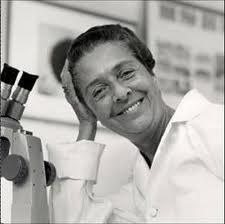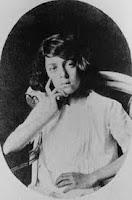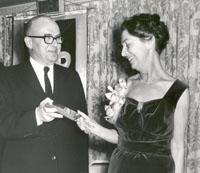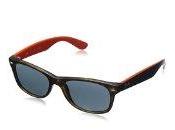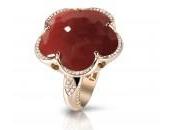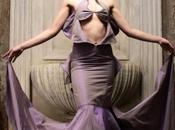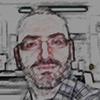Autobiography
My twin sister Paola and I were born in Turin on April 22, 1909, the youngest of four children. Our parents were Adamo Levi, an electrical engineer and gifted mathematician, and Adele Montalcini, a talented painter and an exquisite human being. Our older brother Gino, who died twelve years ago of a heart attack, was one of the most well known Italian architects and a professor at the University of Turin. Our sister Anna, five years older than Paola and myself, lives in Turin with her children and grandchildren. Ever since adolescence, she has been an enthusiastic admirer of the great Swedish writer, the Nobel Laureate Selma Lagerlöf, and she infected me so much with her enthusiasm that I decided to become a writer and describe Italian saga "à la Lagerlöf". But things were to take a different turn.
The four of us enjoyed a most wonderful family atmosphere, filled with love and reciprocal devotion. Both parents were highly cultured and instilled in us their high appreciation of intellectual pursuit. It was, however, a typical Victorian style of life, all decisions being taken by the head of the family, the husband and father. He loved us dearly and had a great respect for women, but he believed that a professional career would interfere with the duties of a wife and mother. He therefore decided that the three of us - Anna, Paola and I - would not engage in studies which open the way to a professional career and that we would not enroll in the University.
Ever since childhood, Paola had shown an extraordinary artistic talent and father's decision did not prevent her full-time dedication to painting. She became one of the most outstanding women painters in Italy and is at present still in full activity. I had a more difficult time. At twenty, I realized that I could not possibly adjust to a feminine role as conceived by my father, and asked him permission to engage in a professional career. In eight months I filled my gaps in Latin, Greek and mathematics, graduated from high school, and entered medical school in Turin. Two of my university colleagues and close friends, Salvador Luria and Renato Dulbecco, were to receive the Nobel Prize in Physiology or Medicine, respectively, seventeen and eleven years before I would receive the same most prestigious award. All three of us were students of the famous Italian histologist, Giuseppe Levi. We are indebted to him for a superb training in biological science, and for having learned to approach scientific problems in a most rigorous way at a time when such an approach was still unusual.
In 1936 I graduated from medical school with a summa cum laude degree in Medicine and Surgery, and enrolled in the three year specialization in neurology and psychiatry, still uncertain whether I should devote myself fully to the medical profession or pursue at the same time basic research in neurology. My perplexity was not to last too long.
In 1936 Mussolini issued the "Manifesto per la Difesa della Razza", signed by ten Italian 'scientists'. The manifesto was soon followed by the promulgation of laws barring academic and professional careers to non-Aryan Italian citizens. After a short period spent in Brussels as a guest of a neurological institute, I returned to Turin on the verge of the invasion of Belgium by the German army, Spring 1940, to join my family. The two alternatives left then to us were either to emigrate to the United States, or to pursue some activity that needed neither support nor connection with the outside Aryan world where we lived. My family chose this second alternative. I then decided to build a small research unit at home and installed it in my bedroom. My inspiration was a 1934 article by Viktor Hamburger reporting on the effects of limb extirpation in chick embryos. My project had barely started when Giuseppe Levi, who had escaped from Belgium invaded by Nazis, returned to Turin and joined me, thus becoming, to my great pride, my first and only assistant.
Ne approfitto per segnalare anche l'interessante articolo di Annarita Ruberto, Rita Levi-Montalcini: 103 Splendide Primavere, con link a numerose risorse e interviste.Fonti e bibliografiaNobel prize, Levi Montalcini imagesource
The heavy bombing of Turin by Anglo-American air forces in 1941 made it imperative to abandon Turin and move to a country cottage where I rebuilt my mini-laboratory and resumed my experiments. In the Fall of 1943, the invasion of Italy by the German army forced us to abandon our now dangerous refuge in Piemonte and flee to Florence, where we lived underground until the end of the war.
In Florence I was in daily contact with many close, dear friends and courageous partisans of the "Partito di Azione". In August of 1944, the advancing Anglo-American armies forced the German invaders to leave Florence. At the Anglo-American Headquarters, I was hired as a medical doctor and assigned to a camp of war refugees who were brought to Florence by the hundreds from the North where the war was still raging. Epidemics of infectious diseases and of abdominal typhus spread death among the refugees, where I was in charge as nurse and medical doctor, sharing with them their suffering and the daily danger of death.
The war in Italy ended in May 1945. I returned with my family to Turin where I resumed my academic positions at the University. In the Fall of 1947, an invitation from Professor Viktor Hamburger to join him and repeat the experiments which we had performed many years earlier in the chick embryo, was to change the course of my life.
Although I had planned to remain in St. Louis for only ten to twelve months, the excellent results of our research made it imperative for me to postpone my return to Italy. In 1956 I was offered the position of Associate Professor and in 1958 that of Full Professor, a position which I held until retirement in 1977. In 1962 I established a research unit in Rome, dividing my time between this city and St. Louis. From 1969 to 1978 I also held the position of Director of the Institute of Cell Biology of the Italian National Council of Research, in Rome. Upon retirement in 1979, I became Guest Professor of this same institute. [fonte nobelprize.org]
stabiachannel.it
nature.com
beckerexhibits.wustl.edu/
